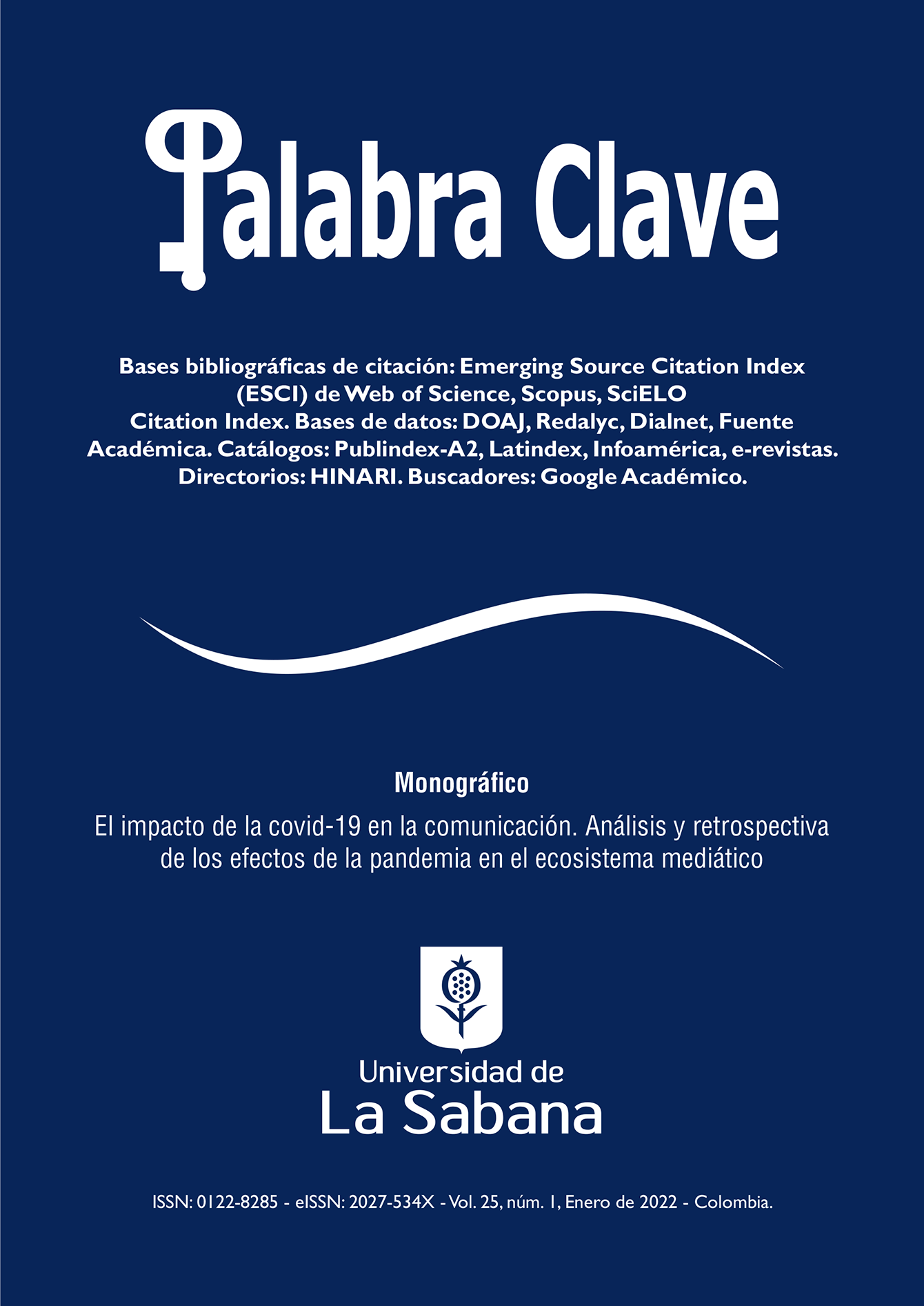Implied and Explicit Information on the COVID-19 Perception in Spanish, German, and Russian Social Media
DOI:
https://doi.org/10.5294/pacla.2022.25.1.3Keywords:
COVID-19, social media, pandemic, perception, perception of the pandemic, social problems, neural network technologiesAbstract
The COVID-19 pandemic radically changed people’s lives and the state of affairs in all spheres of life and transformed environmental ideas, social problems at the micro and macroeconomic levels, and the market mechanism to maintain economic justice. The pandemic consequences have exacerbated individualism, intersectionality, diversity, and inclusiveness issues. Disproportionate risks and worsened outlooks have been observed for socially and economically vulnerable groups. The present cross-cultural study discusses the content of social media on the COVID-19 perception by Spanish, German, and Russian-speaking actors, applying a multimodal approach and using neural network technologies and text analyses. The data analysis made it possible to identify common and distinctive features of communicative actors’ perception of various aspects of the COVID-19 pandemic. With the identity of explicitly expressed issues, the implicit information for the three types of users was significantly different, reflected in the dissimilar course and evolution of the COVID-19 pandemic around the world, shedding light on their cultural and political reasons.
Downloads
References
Aaron M., A., Garrett N., Panayiota P.-Z., Talmina, N. y Linzen T. (2020). Cross-linguistic syntactic evaluation of word prediction models. arXiv:2005.00187 [cs.CL]
Agrati, L. S. et al. (2021). Bridges and mediation in higher distance education. Second International Workshop, HELMeTO 2020, Bari, BA, Italy, 17-18 de septiembre de 2020. Revised Selected Papers. Springer International. DOI: https://doi.org/10.1007/978-3-030-67435-9
Brandon, P., Traylor, A. y Pater, J. (2019). Learning reduplication with a neural network without explicit variables. University of Massachusetts Amherst. Sin publicar. http://works.bepress.com/joe_pater/38/
Casero-Ripollés, A. (2020). Impact of Covid-19 on the media system. Communicative and democratic consequences of news consumption during the outbreak. El Profesional de la Información, 29(2), e290223. DOI: https://doi.org/10.3145/epi.2020.mar.23
Clarke, N. y Furnell, S. (eds.) (2020). Human aspects of information security and assurance. 14th IFIP WG 11.12 International Symposium, HAISA 2020, Mytilene, Lesbos, Greece, 8-10 de julio de 2020, Proceedings. Springer International. DOI: https://doi.org/10.1007/978-3-030-57404-8
Essam, B. A. y Abdo, M.S. (2020) How do Arab tweeters perceive the Covid-19 pandemic? Journal of Psycholinguistic Research, 50, 507-521. DOI: https://doi.org/10.1007/s10936-020-09715-6
Garrett, L. (2001). Understanding media’s response to epidemics. Public Health Reports, 116(2), 87. DOI: https://doi.org/10.1016/S0033-3549(04)50149-8
Glik, D. (2007). Risk communication for public health emergencies. Annual Review of Public Health, 28, 33-54. DOI: https://doi.org/10.1146/annurev.publhealth.28.021406.144123
Gouri, S. B. y Pravat, K. S. (2021). GeoComputation and public health. A spatial approach. Springer. DOI: https://doi.org/10.1007/978-3-030-71198-6
Goyal, M.K. y Gupta, A.K. (2020). Integrated Risk of Pandemic: Covid-19 Impacts, Resilience and Recommendations. Springer.
Heydari, S. T. et al. (2021). The effect of risk communication on preventive and protective behaviors during the Covid-19 outbreak: mediating role of risk perception. BMC Public Health 21(54). DOI: https://doi.org/10.1186/s12889-020-10125-5
Hobbs, A. (2020). Leadership during Covid-19: Conflict and collaboration. Sage. DOI: https://doi.org/10.4135/9781529752021
Horesh, D. y Brown, A. D. (2020). Traumatic stress in the age of Covid-19: A call to close critical gaps and adapt to new realities. Psychological Trauma, 12(4), 331-335. DOI: https://doi.org/10.1037/tra0000592
Kharlamov, A. A. y Pilgun, M. (2020). Neuroinformatics and semantic representations. Cambridge Scholars Publishing.
Liao, H. P. y Wang, J. L. (2021). The impact of epidemic information on the public’s worries and attitude toward epidemic prevention measures during the Covid-19 outbreak. Current Psychology. DOI: https://doi.org/10.1007/s12144-021-01364-9
Linzen, T. (2019). What can linguistics and deep learning contribute to each other? Response to Pater. Language, 95(1), e98-e108. DOI: https://doi.org/10.1353/lan.2019.0015
Martín-Moreno, J. M. et al. (2020). Reflexiones sobre cómo evaluar y mejorar la respuesta a la pandemia de covid-19. Gaceta Sanitaria. DOI: https://doi.org/10.1016/j.gaceta.2020.11.008
McCoy, R. T., Grant, E., Smolensky, P., Griffiths, T. L. y Linzen, T. (2020). Universal linguistic inductive biases via meta-learning. arXiv:2006.16324 [cs.CL]
OMS - Organización Mundial de la Salud (2021). Global research on coronavirus disease (Covid-19). WHO. https://www.who.int/emergencies/diseases/novel-coronavirus-2019/global-research-on-novel-coronavirus-2019-nco
Pater, J. (2019). Generative linguistics and neural networks at 60: foundation, friction, and fusion. Language, 95(1), e41-e7. DOI: https://doi.org/10.1353/lan.2019.0009
Prasad, A. (2020). The organization of ideological discourse in times of unexpected crisis: Explaining how Covid-19 is exploited by populist leaders. Leadership, 16(3), 294-302. DOI: https://doi.org/10.1177/1742715020926783
Quick, L. (2020). Managing events: Real challenges, real outcomes. Sage.
Roundtree, A. K. (2018). Hospital tweets on H1N1 and death panels: Text mining the situational crisis communication response to health crises and controversies. Kome, 6(1), 32-62. DOI: https://doi.org/10.17646/KOME.2018.13
Singh, L. et al. (2020). A first look at Covid-19 information and misinformation sharing on Twitter. arXiv:2003.13907v1 [cs.SI]. https://arxiv.org/pdf/2003.13907.pdf
Stefanidis, A. et al. (2017). Zika in Twitter: Temporal variations of locations, actors, and concepts. JMIR Public Health and Surveillance, 3(2), e22. DOI: https://doi.org/10.2196/publichealth.6925
Wang, P-W. et al. (2021). Sources of Covid-19-related information in people with various levels of risk perception and preventive behaviors in Taiwan: A latent profile analysis. International Journal of Environmental Research and Public Health, 18(4), 2091. DOI: https://doi.org/10.3390/ijerph18042091
Wasdani, K. P. y Prasad, A. (2020). The impossibility of social distancing among the urban poor: the case of an Indian slum in the times of Covid-19. Local Environment, 25(5), 414-418. DOI: https://doi.org/10.1080/13549839.2020.1754375
Wenham, C., Smith, J. y Morgan, R. (2020). Covid-19: The gendered impacts of the outbreak. The Lancet, 395(10227), 846-848. DOI: https://doi.org/10.1016/S0140-6736(20)30526-2
Xifra, J. (2020). Comunicación corporativa, relaciones públicas y gestión del riesgo reputacional en tiempos del covid-19. El Profesional de la Información, 29(2), e290220. DOI: https://doi.org/10.3145/epi.2020.mar.20
Published
How to Cite
Issue
Section
License
Copyright (c) 2022 Palabra Clave

This work is licensed under a Creative Commons Attribution-NonCommercial-NoDerivatives 4.0 International License.
1. Proposed Policy for Journals That Offer Open Access
Authors who publish with this journal agree to the following terms:
- Authors retain copyright and grant the journal right of first publication with the work simultaneously licensed under a Creative Commons Attribution License that allows others to share the work with an acknowledgement of the work's authorship and initial publication in this journal.









